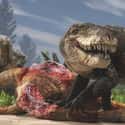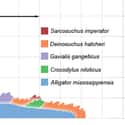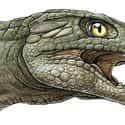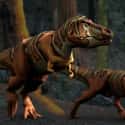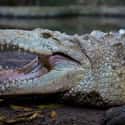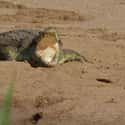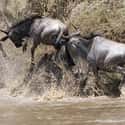-
(#1) It Was An Apex Predator That Could Devour Bones
Dinosaurs weren't at the top of the food chain, after all. The discovery of Razanandrongobe sakalavae, or Razana for short, uncovered a new apex predator. With serrated teeth as large as bananas, Razana took on dinosaurs in prehistoric Madagascar.
And dinosaur flesh wasn't the only thing that fell prey to the enormous prehistoric crocodile - Razana's teeth were sharp enough to devour bone and hard tissue.
-
(#2) It Shares An Important Similarity With T. Rex
Razana was a dinosaur-hunting crocodile, but the species shared some surprising similarities with Tyrannosaurus rex. Both predators had serrated teeth that were quite similar, giving them an advantage when hunting. Both also shared a similarly oversized jaw filled with those teeth.
In fact, the scientists who uncovered Razana note that the prehistoric crocodile's teeth are "remarkably large." Razana boasted teeth "even larger than... Tyrannosaurus rex."
Razana and T. rex never battled it out, though. Razana lived about 165 million years ago, while the T. rex didn't fully emerge until around 67 million years ago.
-
(#3) Today's Crocodiles Are Slow Compared To Razana
Crocodiles today spend a fair amount of time lying in rivers. Razana was different. Like other notosuchians, Razana primarily lived on land. And unlike today's crocodiles, Razana was designed for speed. Razana's legs didn't splay out like today's crocodiles. Instead, they went straight down from the creature's body.
That means Razana was capable of moving much faster than crocodiles and alligators today. In fact, Razana could gallop.
-
(#4) Razana Wasn't The Only Prehistoric Crocodile - But It Was One Of The Biggest
The crocodile family had several prehistoric members, and many were significantly larger than current crocodiles and alligators. Sarcosuchus imperator, for example, grew up to 39 feet long. Purussaurus brasilensis could be 34 feet long.
Razana was in a class of its own. While the limited fossil evidence makes it difficult to establish an exact size, scientists believe Razana was larger than Sarcosuchus.
-
(#5) Razana Belongs To An Ancient Group Of Hardy Crocodiles
Razana proved to be the earliest notosuchian ever found. The group notosuchia, a branch of the larger crocodylomorpha, died out 10 million years ago. When the scientists identified Razana as a notosuchian, it was a major breakthrough in the field.
Razana was 42 million years older than any other notosuchian fossil, and Razana was also bigger than other members of the group.
-
(#6) The Prehistoric Crocodile Had An Advantage Over T. Rex
Today, we often think of T. rex as the apex predator of the entire dinosaur era. But Razana had a major advantage over T. rex: Razana could survive swallowing bone. Scientists believe the creature was durophagous, meaning it could crush bones with its jaw and eat them whole.
The ability to eat bones gave Razana a significant advantage over other predators. Razana benefited from a broader food source, which may explain its success.
-
(#7) The Find Solves The Ghost Crocodile Mystery
For years, scientists believed the group notosuchia dated back at least to the Jurassic period. But the lack of fossil evidence meant they couldn't prove it. For that reason, notosuchia's evolutionary tree was termed a ghost lineage.
With the discovery of Razana, scientists have now filled in the tree, demonstrating that notosuchia dates back at least 42 million years earlier than previously thought.
-
(#8) Razana Dominated The Jurassic Period, Once Thought To Belong To Dinosaurs
Dinosaurs weren't the only creatures that dominated the Jurassic period. Razana was one of the most fearsome predators of the era, even preying on dinosaurs. Scientists named Razanandrongobe sakalavae for its region and ancestors. The name means "giant lizard ancestor from the Sakalava region."
While the area of Madagascar where Razana dominated 165 million years ago today goes by the name Mahajanga, during Razana's day the geography was different. Madagascar had just broken off from Gondwana, the southern supercontinent.
-
(#9) It Likely Went After Large Prey
Today's crocodiles might sometimes take on a zebra or even a wildebeest, but a crocodile's typical diet consists mostly of fish and birds. Scientists believe that Razana, the prehistoric crocodile, could have eaten other dinosaurs.
Paleontologist Cristiano Dal Sasso from the Natural History Museum of Milan reports, “Like these and other gigantic crocs from the Cretaceous, Razana could outcompete even theropod dinosaurs, at the top of the food chain.”
-
(#10) The Mysterious Creature Once Ruled Madagascar
Scientists first uncovered the massive prehistoric crocodile in 2006. A team made up of French and Italian paleontologists discovered the fossils in Madagascar. For over 10 years, the scientists thought the fossils came from an Archosaur. The scientists speculated for years on whether the creature was a carnivorous dinosaur or a prehistoric crocodile.
The team, made up of Simone Maganuco, Cristiano Dal Sasso, and Giovanni Pasini, named the creature Razanandrongobe sakalavae.
-
(#11) Scientists Were Surprised By Razana's Size
Prehistoric crocodiles ranged in size from fairly small to enormous. Anatosuchus, for example, who lived 120 million years ago, was two feet long. The largest known crocodile ancestor, Sarcosuchus, was a stunning 39 feet long, earning it the nickname SuperCroc.
But Razana might prove even more massive than Sarcosuchus, according to scientists. Razana also predates Sarcosuchus, surprising scientists with its size. As the researchers state, Razana's discovery "documents a dramatic, somewhat unexpected, size increase in the early history of the group."
-
(#12) Razana's Lineage Includes The Boar Crocodile And Modern Crocs
Razana isn't a direct ancestor of modern crocodiles, but they're close cousins. The scientists who discovered Razana grouped the prehistoric crocodile with the notosuchians. That group is related to Kaprosuchus, a Late Cretaceous crocodile ancestor.
Kaprosuchus also goes by the name "boar crocodile," because of its large canines. Scientists trace the lineage of modern crocodiles back to both Razana and Kaprosuchus.
-
(#13) There's Much More To Learn About Razana
The fragmentary fossil evidence scientists have found paints an incomplete picture of Razana. In 2006, scientists found part of a jaw bone and seven teeth. Since then, the scientists uncovered additional bone fragments, including ones from the creature's skull.
These pieces provide valuable clues about Razana, but scientists need additional evidence to settle more mysteries. For example, Razana may have been able to stand on two feet - but scientists need more skeletal remains to know for sure.
-
(#14) There Might Be More Prehistoric Crocodiles To Discover
There may be an even older ancestor of Razana. In their PeerJ article, the scientists who discovered Razana note that, based on evolutionary evidence, Razana's family, the notosuchians, likely evolved around 74 million years earlier than previous fossil evidence indicated.
Razana only predates the known fossil record by 42 million years, however. That might mean there's an even earlier ancestor of Razana waiting to be discovered.
New Random Displays Display All By Ranking
About This Tool
Crocodiles can always be equated with ferocity and cold blood in our impressions, horror movies such as Killer Crocodile and Lake Placid have deepened this impression. Compared with the crocodiles that lived on the prehistoric earth, the crocodiles on the earth today are relatively small creatures. As early as the 1880s, geologists and archaeologists all over the world successively discovered huge tooth and spine fossils and were confirmed that they are fossils of giant prehistoric crocodiles.
These giant prehistoric crocodiles were almost contemporary creatures with dinosaurs, and they compete for supremacy in nature, follow the laws of nature and eventually become extinct. Here the random tool introduced 14 details about this giant prehistoric crocodile.
Our data comes from Ranker, If you want to participate in the ranking of items displayed on this page, please click here.










